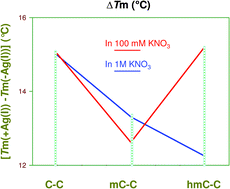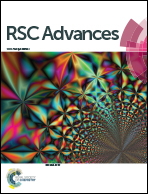Silver(i) ions modulate the stability of DNA duplexes containing cytosine, methylcytosine and hydroxymethylcytosine at different salt concentrations†
Abstract
Silver(I) ions can stabilize cytosine–cytosine, cytosine (C)–methylcytosine (5mC) and cytosine–hydroxymethylcytosine (5hmC) mismatched-base pairs. While cytosine modifications regulate DNA stability to regulate cellular functions, silver ions can modulate the stability of C–C, C–5mC and C–5hmC containing DNA duplexes in a salt concentration dependent manner.


 Please wait while we load your content...
Please wait while we load your content...